How I Learned to Litigate at the Movies
ABA members can listen to August’s CLE, “How I Learned to Litigate at the Movies,” through CLE Now! at any time for free.
We swim in a sea of popular culture. Whether it comes at us in the form of television, movies, radio, novels or music, pop culture is everywhere, and most of us enjoy it.
But pop culture is no longer just the fluff of modern society. Even though it’s intended to be consumed and quickly forgotten, we need to take pop culture seriously, particularly because a great deal of it concerns law and lawyers.
Lawyers must realize that pop culture teaches the general public most of what it knows—or thinks it knows—about the legal system. And even though many of those lessons are wrong, what the public believes about the legal system has a significant effect on how lawyers and the courts do their work.
Studies show that people who watch Judge Judy think it’s the judge who asks the questions at trial. L.A. Law gave law practice such a glamorous veneer that it sparked a boom in law school applications. In surveys, regular viewers thought of lawyers as wealthy and good-looking more often than people who didn’t watch the show. The “C.S.I. effect” has created a new and often unreasonable influence for forensic evidence: Without it, prosecutors have trouble getting past reasonable doubt; and where it does exist, jurors perceive absolute proof of guilt.
People who have learned their law from TV expect that opening and closing arguments will be short and punchy and based on a strong, media-inspired storyline. They want you to use demonstrations, visual aids and simulations, and it will help if you can pull a rabbit out of a hat on cross.
Pop culture attests that good lawyers find out and reveal the truth about what happened, and breach the attorney-client privilege to protect the public from vicious criminals.
But lawyers aren’t immune from the effects of how they’re portrayed by popular culture. We also take lessons from movies and TV.
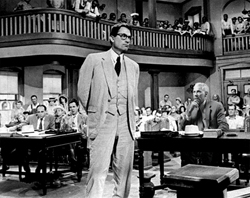
Photo by Universal/The Kobal Collection
Photo Illustration: Kristine Strom
Just like everyone else, some of what we learn is wrong. In Germany, young lawyers make motions in court that are unknown to German law because they saw them on American TV shows. A new law firm in Washington, D.C., conducted meetings every morning in which the lawyers reported on their cases. It was a total waste of time, but they got the idea from L.A. Law.
Films also remind us how lawyers and law firms can go terribly wrong. Michael Clayton, for example, portrays a pack of greedy and unethical attorneys who specialize in dirty tricks, struggle with substance abuse and betray their clients. Then there are the films that teach and inspire us about how we should advocate on behalf of clients in real life.
To Kill a Mockingbird made many of us want to become lawyers in the first place—it had that effect on me. Films like Inherit the Wind, Philadelphia and In the Name of the Father show lawyers at their very best, standing up for clients who are despised.
We can even take practical lessons from what we see on the big (or little) screen. In the essays that follow, four top litigation experts use some of their favorite films—not all of them about lawyers—to illustrate important lessons about trial technique.
So enjoy legal pop culture, but don’t forget that no matter how trashy, inaccurate and even downright ridiculous it often appears to be, it always affects those who consume it. Whether we like it or not, we must take that impact into account in the way we conduct ourselves as lawyers.
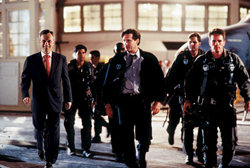
Photo by Universal/The Kobal Collection
Illustration: Kristine Strom
THE FILM: Independence Day
THE LESSON: You’ll make the most impact with a big bang approach
By Steven O. Rosen
An alien spaceship glides toward earth, so huge that it casts a shadow over the entire moon. So begins Independence Day, Hollywood’s big summer blockbuster of 1996.
The alien ship quickly launches smaller craft that hover above major cities around the world before destroying them.
As the movie approaches its climax, U.S. President Thomas Whitmore is holed up at what’s left of an Air Force base in New Mexico’s legendary Area 51, where he addresses a crowd of survivors as a motley assortment of pilots—himself included—prepare for a last-ditch attack against the alien mother ship:
“In less than an hour, aircraft from here will join others from around the world. Perhaps it’s fate that today is the Fourth of July, and you will once again be fighting for our freedom. Not from tyranny, oppression or persecution, but from annihilation. And should we win the day, the Fourth of July will no longer be known as an American holiday, but as the day the world declared in one voice: ‘We will not go quietly into the night! We will not vanish without a fight! We’re going to live on! We’re going to survive!’ ”
Amid the special effects excitement and a rousing climactic battle—the aliens lose again!—the writer and director of Independence Day give us an important lesson about how to tell a story and how to persuade: Start big and end big. To borrow a term from astrophysics, it’s the big-bang approach.
This is a winning approach for lawyers, whether structuring negotiations with opposing counsel, delivering an opening statement or closing argument, writing a brief in support of a motion, or setting the order of witnesses at trial. If you want to be effective, the movies teach, don’t bury the best stuff in the middle.
That lesson also is demonstrated in films with legal themes.
Class Action (1991), applies the big-bang approach to arguing motions. A plaintiffs personal injury lawyer played by Gene Hackman starts oral argument of his motion to compel as follows:
“Your honor, the court has before it a discovery motion compelling the defendant to supply the names, job descriptions, current addresses of all Argo employees involved in the design of the Meridian model between 1980 and 1985.”
Those 37 words launch the oral argument with a bang by stating exactly what the plaintiff seeks. Not necessary, you think? Then perhaps you might reflect on how often you’ve heard a client, opposing counsel, judge, arbitrator or mediator at some point say to you, “OK, but tell me just what is it that you want.”
DELIVER THE FIREWORKS
A third example of the big-bang approach is given in Judgment at Nuremberg, the 1961 film based on the trials of doctors, judges and other professionals charged with committing war crimes under the Nazi regime in World War II. The movie focuses on the prosecution of Ernst Janning, one of four fictional judges on trial. The American prosecutor, played by Richard Widmark, concludes his direct examination of friendly witness Karl Wieck, a former German judge as follows.
Q: Was it necessary for judges to wear any distinctive mark on their robes in 1935?
A: The so-called führer’s decree required judges to wear the insignia of the swastika on their robes.
Q: Did you wear such an insignia?
A: No. I would have been ashamed to wear it.
Q: Did you resign in 1935?
A: Yes, sir.
Q: Did Ernst Janning wear a swastika on his robe?
A: Yes.
The prosecutor’s direct exam was not linear, asking about events in chronological order. Rather, and deliberately, it was set up to end with a bang, and that made the chances of a successful cross-exam by opposing counsel less likely.
Start big. End big. Start with a bang. End with a bang. As Will Smith’s Air Force Capt. Hiller says at the end of Independence Day to a young boy whom he’s befriended: “Didn’t I promise you fireworks?”
“Yeah.”
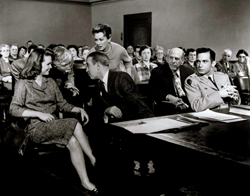
Photo by 20th Century Fox/The Kobal Collection
Illustration: Kristine Strom
THE FILM: Anatomy of a murder
THE LESSON: Chronology can be the key to breaking down a witness’ story on cross
By Paul Bergman
If there were a museum of courtroom disasters, prosecutor Claude Dancer’s cross-examination of Mary Pilant in Anatomy of a Murder (1959) surely would be one of the top exhibits. Watching Dancer, museum visitors would see in excruciating detail some of the worst mistakes you can make on cross.
Even allowing for dramatic license, Anatomy of a Murder is the grittiest and most realistic courtroom film ever made. Director Otto Preminger defied the Production Code and local censorship boards by focusing the plot on an alleged rape and a pair of women’s panties. (The stellar cast includes attorney Joseph N. Welch as the judge. Just a few years earlier, Welch helped bring down Sen. Joseph McCarthy with his dramatic rebuke, “Have you no sense of decency, sir?”)
Posted to an Army base in Michigan’s remote Upper Peninsula, Lt. Frederick Manion (played by Ben Gazzara) is charged with murdering Barney Quill, the owner of a local inn. After listening to an ethically questionable lecture from defense attorney Paul Biegler (James Stewart) on possible defenses to murder, Manion claims that he became temporarily insane after his wife Laura (Lee Remick) told him that Quill had brutally raped her. He was acting on an “irresistible impulse” when he walked to the inn and shot Quill.
Prosecutor Dancer (George C. Scott) counters that Laura and Quill were having an affair, and that Manion was perfectly sane when he beat Laura and shot Quill after learning about it.
At the trial, surprise defense witness Pilant fills a huge gap in Manion’s dubious rape story by producing Laura’s torn panties. Biegler displays the panties—quite modest by current fashions—for all to see. Pilant, who manages Quill’s inn, testifies that the day after he was killed, she was, as usual, sorting the inn’s laundry when she found the panties at the bottom of his laundry chute. Pilant had tossed the panties into the rag bin, but brought them to court when she realized their significance to the case.
FATAL BLUNDER
Dancer cross-examines Pilant ferociously. hadn’t she been Quill’s lover? Isn’t she lying about finding the panties to get back at him for cheating on her with Laura? Tormented by Dancer’s repeated accusations that she and Quill were lovers, Pilant stammers, “It’s not true. Barney Quill was my … .” When she hesitates, Dancer goes in for the kill: “Barney Quill was what, Miss Pilant?”
Finally, Pilant blurts out her secret: “Barney Quill was my father!”
Dancer slinks meekly back to the prosecutor’s table, pausing only to say, “No more questions.”
Dancer’s first problem, of course, is that he asks Mary Pilant a key question without knowing for sure what her answer will be, and the bomb she drops on him shatters his “jealous lover” theory.
But Dancer also is intent on using bullying tactics to make Pilant out to be a perjurer. As a result, he never stops to consider that the chronology of events should cast doubt on her story.
Given the fact that her father was viciously murdered, is it likely that the very next day she would be tending to mundane chores, such as sorting the inn’s laundry? Wouldn’t she take time off to grieve, plan a funeral and tend to her father’s business affairs? So might she be mistaken about when she found the panties? Might she have found them some days after her father was killed, when she returned to work? And if so, wouldn’t Laura—who was terrified of her husband—have had ample time to dump the torn undies into Barney’s laundry chute?
Often, lawyers are all too ready to imitate Claude Dancer by going for home runs when conducting cross-exams. A more effective, if less dramatic, strategy would be to undermine inferences adverse to your client by bringing the implausible aspects of the witness’ story to the surface. And organizing events chronologically often is an effective way to carry out that strategy.
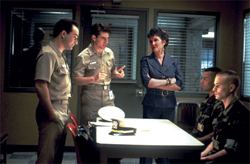
Photo: Columbia/Tri-Star/The Kobal Collection
Illustration: Kristine Strom
THE FILM: A Few Good Men
THE LESSON: Jurors give their own meaning to the different ways that men and women express themselves
By M.J. Tocci
Consider the contrasting communication styles of two key characters in A Few Good Men, the 1992 film about a trio of military lawyers who must prove a cover-up by a base commander to save two Marines charged with murdering another soldier.
At one end of the spectrum is Marine Col. Nathan Jessep, the base commander. When Jessep, memorably played by Jack Nicholson, is called to testify, he enters the courtroom with the fanfare befitting his rank. His demeanor is confident—bordering on arrogant. His manner of speech is direct, unequivocal and delivered with volume, emotion and authority. He is an instantly compelling and authoritative witness.
Contrast Jessep with Lt. Cmdr. JoAnne Galloway (Demi Moore) as she seeks to oversee the defense in the high-profile murder case. Even as she tries to convince the Navy brass that she has the knowledge, expertise and commitment necessary to tackle this politically sensitive case, she comes across as equivocal, indirect and halting. Her statements sound more like questions because of the rising inflection in her voice. She doesn’t ask directly or energetically for what she wants and instead speaks softly, with minimal eye contact and little show of emotion. The assignment instead goes to a lower-ranking colleague, Lt. Daniel Kaffee (Tom Cruise), who has practically no actual trial experience.
Is it just a case of movie stereotypes? Probably not. After studying jury trials in North Carolina over a three-month period, anthropologist William M. O’Barr concluded in Linguistic Evidence that jurors have different perceptions of what he termed powerful and powerless language. O’Barr determined that male and female witnesses with a powerful speech style elicited a significantly more favorable response from jurors, but that women tended to speak less powerfully than men. Women using powerless speech styles were seen as generally less credible, especially by female jurors.
And yet simply “acting like men” isn’t the answer for women. Research indicates that women are perceived to be less likable as they become more powerful and confident, but if they appear to be less confident they are viewed as more likable. At the same time, gender is fundamental to our sense of who we are.
Galloway embodies that conflict. Substance and style converge as she—like so many women in the real world—seeks a communication approach that is both authentic and effective.
A MANNER OF SPEAKING
So now your own witness raises her right hand and takes the oath, and you begin your direct examination with the usual preliminary questions. Because you have not yet covered anything substantive, it appears that nothing significant has happened. Research shows, however, that multitasking jurors are making instantaneous judgments about her competence, her trustworthiness and even her likability. These judgments are based on a number of factors—most of which are invisible and subconscious. If it is indeed true that we never have a second chance to make a first impression, we should understand how that first impression is made.
One important factor is conversational style. In his 2007 bestseller Blink: The Power of Thinking Without Thinking, Malcolm Gladwell argues that we form first impressions in the blink of an eye. Jurors are “thin slicing” when they simultaneously evaluate the witness’s eye contact, gestures, speech, appearance and testimony. Conversational style is one of the thin slices that enhance or diminish the witness’s credibility.
Sociolinguist Deborah Tannen tells us in Talking from 9 to 5: Women and Men at Work (1995) that, rather than recognize different conversational styles as the cause of confusion and misunderstanding, we challenge the speaker’s intentions (“she thinks she’s so smart”) or her abilities (“she doesn’t sound very sure”) or her character (“she is evasive in answering questions”).
The possibility that conversational style will affect your witness’s credibility should influence your preparation of the witness, your direct examination strategy, and how you use closing argument to address possible misunderstandings by the jury of your witness’s testimony.
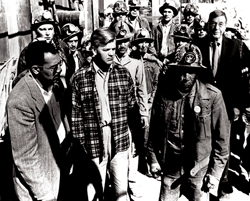
Photo: International Union of Mine,
Mill & Smelter Workers/The
Kobal Collection
Illustration: Kristine Strom
THE FILM: Salt of the Earth
THE LESSON: Your case is about real people telling their stories
By Michael E. Tigar
We all know that at trial we must present jurors with a coherent story of the case. But we often forget that a story is told by people, to other people. The story is built up from testimony of witnesses, who bring their version of what happened, and their sense of the justice or injustice of it. With our guidance, these witnesses speak to the jurors, each of whom brings his or her own set of attitudes and personal experiences to the process.
To tell the story of our case simply and persuasively, we must learn to share vicariously the lives and experiences of our clients. After all, Clarence Darrow had never walked the corridors of madness as had Leopold and Loeb, nor ever braved a white mob while trying to move a black family into their new home, nor lived among union organizers in the mines, mills and forests. Yet, more eloquently than any other lawyer of his time, Darrow was able to summon up images of those experiences for judges and jurors.
Salt of the Earth is not a movie about lawyers, and it’s hardly even about the law. But it is a film about seeking justice, and it can teach us how to listen to people’s grievances and then tell their stories.
Salt of the Earth was produced in 1954. It depicts an actual Mine, Mill & Smelter Workers strike against a zinc mining company in New Mexico. The striking local was predominantly Hispanic, and the demands included equal pay with Anglo workers, decent living conditions in the company town and a safe working environment.
The company refused to negotiate. It closed off access to the company-owned food store. It tried to bring in scab labor. Eventually, the company obtained a Taft-Hartley injunction that forbade the striking miners to picket. At that point, the miners’ wives asserted themselves and took up the picket duties. Eventually, the company agreed to most of the miners’ demands.
A film like this, especially told from the perspective of the workers, was not easy to make in the heart of the McCarthy era. Union leaders were targets of red-baiting. Director Herbert J. Biberman and his co-writer, Michael Wilson, were members of the Hollywood 10 blacklist. The producers had trouble getting financing, there were efforts to disrupt the filming, and their principal actress—Rosaura Revueltas, one of the few professionals in the cast—was arrested and deported to Mexico. The film did not have a general release in the United States until 1965.
But 54 years after it was made, Salt of the Earth treats themes that still are volatile in U.S. society: workers’ rights; health care; the struggle for gender equality; and efforts to divide people based on their race, ethnicity or immigration status.
These are the film’s lessons for trial lawyers:
First, most of the actors were nonprofessionals. They included Juan Chacón, the male lead, who was a union local president, and Clint Jencks, who essentially appeared in his real-life role as an official of the international union.
These people are witnesses—they are miners and miners’ families, telling their own stories in compelling fashion. If a Hollywood writer and director can encourage performances like that, you as a trial lawyer can do it as well. But you must listen and care as deeply as the people who made this film, and think as creatively as they did about how your witnesses present themselves.
Second, the film teaches us to look deeply into the human situations that our clients bring to us, and to search for causes rather than litigate the effects.
Third, the film reinforces our sense that we can—as citizens and as trial lawyers—dare to talk about fundamental issues of justice and injustice, knowing that we must awaken in jurors the desire to reaffirm what is right and change what is not.
Sidebar
ABA Connection offers four easy ways to get low cost/no cost CLE credit
Live Call-in Teleconferences
This Month’s “How I Learned to Litigate at the Movies,” is from 1-2 p.m. (ET) Aug. 20.
To register, call 1-800-285-2221 between 8:30 a.m. and 6:30 p.m. (ET) weekdays starting July 21, or go to abanet.org/cle/connection.html. Multiple participants may listen via speakerphone, but each individual who wants CLE credit must register separately.
CLE on CD
Previous ABA Connection programs are available on CD for $50 each. Order online at abaclecatalog.org (key words: ABA Connection), or call 1-800-285-2221.
Online Access – At No Cost
Online Streaming Audio, available starting Aug. 25. To register, go to abanet.org/cle/connection.html. Past programs here.
CLE on Podcast
Podcast downloads are available starting Aug. 25.
Coming in September: “Wrangling Over Water Rights.”
Correction
In "How I Learned to Litigate at the Movies," August, the following photo credits should have been included: Max Dolberg photographed Michael Asimow and Paul Bergman; Daniel Root photographed Steven Rosen; Gary Yasaki photographed M.J. Tocci; and Rick Hovis photographed Michael Tigar.This article also incorrectly identified Area 51, a tract of federal land that includes an Air Force base, as being in New Mexico. Area 51 is located in Nevada.
The Journal regrets the errors.




